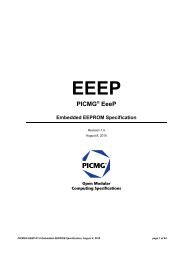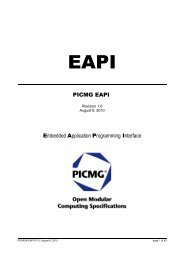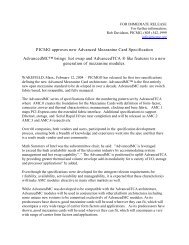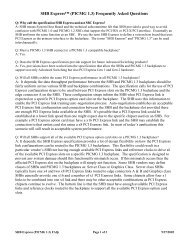PICMG 2.14, CompactPCI Multicomputing
PICMG 2.14, CompactPCI Multicomputing
PICMG 2.14, CompactPCI Multicomputing
Create successful ePaper yourself
Turn your PDF publications into a flip-book with our unique Google optimized e-Paper software.
FOR INFORMATION ONLY;<br />
DO NOT ATTEMPT TO DESIGN FROM THIS DOCUMENT<br />
• Supported features (i.e. multi and broad cast, promiscuous mode, nodal quiescing for hot<br />
swap, reset, driver unload)<br />
• Non-transparent bridging devices and resources to be utilized<br />
• Byte ordering<br />
• Hot Swap re-enumeration of bus and effect on system communications<br />
• High Availability (compatible with the pending <strong>PICMG</strong> 2.13 specification for dual-host<br />
high availability)<br />
PROTOCOL OVERVIEW<br />
The purpose of this protocol is to<br />
• Support up to 4096 MCNodes communicating in a heterogeneous (single global PCI memory address<br />
space) PCI environment<br />
• Occupy Layer 2 (data link) of the OSI reference model<br />
• Allow for dynamic discovery and configuration of network elements<br />
• Emulate broadcast and multicast capabilities to allow higher level network protocols to operate via<br />
this data link layer<br />
• Accommodate Compact PCI Hot Swap capabilities<br />
• Provide for fault detection, containment and notification in a High Availability environment<br />
• Allow extensions in subsequent versions of this specification which take advantage of additional<br />
hardware features<br />
• Ensure interoperability among all vendors complying with this specification<br />
The information in this chapter is intended to be descriptive in nature, and is not an actual part of the<br />
specification. Subsequent chapters in the full <strong>CompactPCI</strong> MultiComputing specification specify the<br />
protocol in detail.<br />
Protocol Model<br />
The general model of the MCNet protocol is that of a dedicated shared memory region for the<br />
exchange of messages. The entire protocol takes place within a single global PCI memory address<br />
space. Each MCNode of a pair of MCNodes desiring to communicate allocates regions of the global<br />
PCI memory space for communication and control structures dedicated to that single connection. A<br />
single System Node manages the discovery and setup of the remaining connection pairings on<br />
demand.<br />
MultiComputing Devices<br />
The term MultiComputing Device (MCDevice) refers to actual PCI hardware that conforms to the<br />
PCI specification for a PCI device/function. The MCDevice is discovered and managed by the PCI<br />
enumeration software. Resources are allocated by the PCI system software via the PCI type 0<br />
configuration header mechanism. For a PCI device/function to be an MCDevice, it must have at<br />
least a 4k byte PCI memory space allocation.<br />
MCDevices are important to the <strong>2.14</strong> protocol because they form the basis for communications<br />
among hardware provided by multiple vendors. Additionally, MCDevices are treated as hot<br />
<strong>PICMG</strong> <strong>2.14</strong> R 1.0 <strong>CompactPCI</strong> MultiComputing Short Form Specification, page 3
















